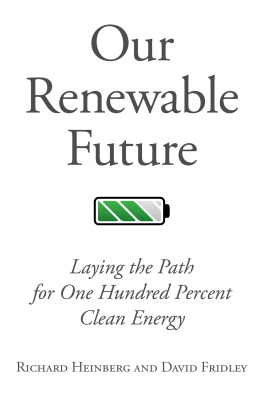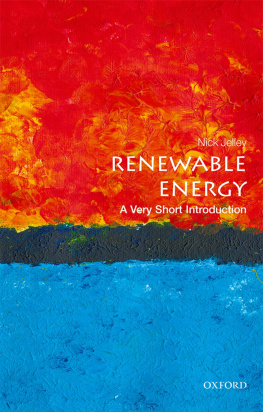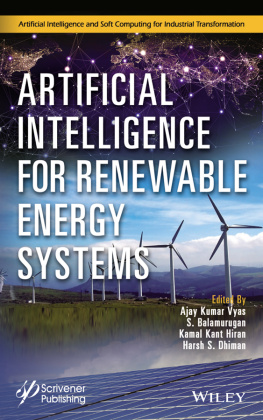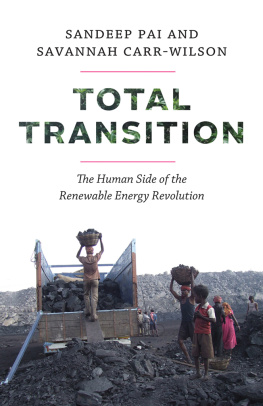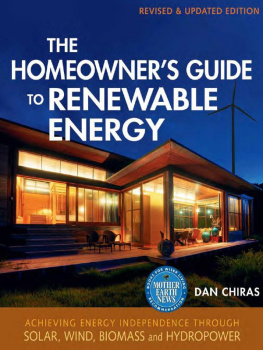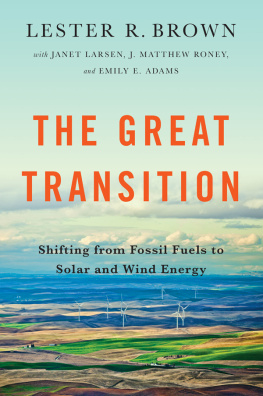About Island Press
Since 1984, the nonprofit organization Island Press has been stimulating, shaping, and communicating ideas that are essential for solving environmental problems worldwide. With more than 800 titles in print and some 40 new releases each year, we are the nations leading publisher on environmental issues. We identify innovative thinkers and emerging trends in the environmental field. We work with world-renowned experts and authors to develop cross-disciplinary solutions to environmental challenges.
Island Press designs and executes educational campaigns in conjunction with our authors to communicate their critical messages in print, in person, and online using the latest technologies, innovative programs, and the media. Our goal is to reach targeted audiencesscientists, policymakers, environmental advocates, urban planners, the media, and concerned citizenswith information that can be used to create the framework for long-term ecological health and human well-being.
Island Press gratefully acknowledges major support of our work by The Agua Fund, The Andrew W. Mellon Foundation. Betsy & Jesse Fink Foundation. The Bobolink Foundation. The Curtis and Edith Munson Foundation. Forrest C. and Frances H. Lattner Foundation. G.O. Forward Fund of the Saint Paul Foundation. Gordon and Betty Moore Foundation. The Kresge Foundation. The Margaret A. Cargill Foundation, New Mexico Water Initiative, a project of Hanuman Foundation, The Overbrook Foundation. The S.D. Bechtel. Jr. Foundation, The Summit Charitable Foundation. Inc., V. Kann Rasmussen Foundation. The Wallace Alexander Gerbode Foundation, and other generous supporters.
The opinions expressed in this book are those of the author(s) and do not necessarily reflect the views of our supporters.

Copyright 2016 Post Carbon Institute
All rights reserved under International and Pan-American Copyright Conventions. No part of this book may be reproduced in any form or by any means without permission in writing from the publisher: Island Press, 2000 M Street NW, Suite 650, Washington, DC 20036
ISLAND PRESS is a trademark of the Center for Resource Economics.
Library of Congress Control Number: 2016931452
ISBN-13: 978-1-61091-779-7 (paper)
ISBN-13: 978-1-61091-780-3 (electronic)
Printed on recycled, acid-free paper 

Manufactured in the United States of America
10 9 8 7 6 5 4 3 2 1
Keywords: Biomass, cap and trade, carbon capture, carbon tax, coal, consumerism, electric cars, electricity, energy efficiency, energy grid, energy storage, energy supply, fossil fuels, geothermal, gross domestic product, hydrogen, hydropower, industrialization, natural gas, net energy, nuclear, oil, petroleum, photovoltaic cells, renewable energy, solar, solar panels, wind, wind turbines
Contents
Figures and Table
Figures
Table
Acknowledgments
The authors extend their deepest thanks to Post Carbon Institute staff for their work on this book: Daniel Lerch for his extensive editorial efforts; Asher Miller for guiding the project from inception to completion; and Leslie Moyer for coordinating input from contributors. Many thanks also to Rebecca Bright and Sharis Simonian from Island Press for helping make this book a reality; to Adrian Wiegman and Jeff Rutherford for their research assistance; to the participants in our advisor summits held in New York and San Francisco in summer 2015; to Levana Saxon for facilitating those gatherings; and to our many reviewers and contributors, including Philip Ackerman-Leist, David Blittersdorf, Mike Bomford, Mik Carbajales-Dale, Heather Cooley, Casey Haskell, Elena Krieger, Susan Krumdieck, David Morris, Diane Moss, Mateo Nube, Cindy Parker, Anthony Perl, David Pomerantz, James Rose, Brian Schwartz, Bill Sheehan, Stiv Wilson, and Miya Yoshitani. Finally, special thanks to Irene Krarup and the trustees of the V. Kann Rasmussen Foundation for their support of this project, and to PJ and LH for their steadfast support of Post Carbon Institute.
Introduction
T HE NEXT FEW DECADES will see a profound and all-encompassing energy transformation throughout the world. Whereas society now derives the great majority of its energy from fossil fuels, by the end of the century we will depend primarily on renewable sources like solar, wind, biomass, and geothermal power.
Two irresistible forces will drive this historic transition.
The first is the necessity of avoiding catastrophic climate change. In December 2015, 196 nations unanimously agreed to limit global warming to no more than two degrees Celsius above preindustrial temperatures. While some of this reduction could technically be achieved by carbon capture and storage from coal power plants, carbon sequestration in soils and forests, and other negative emissions technologies and efforts, the great majority of it will require dramatic cuts in fossil fuel consumption.
The second force driving a post-carbon energy shift is the ongoing depletion of the worlds oil, coal, and natural gas resources. Even if we do nothing to avoid climate change, our current energy regime remains unsustainable. Though Earths crust still holds enormous quantities of fossil fuels, economically useful portions of this resource base are much smaller, and the fossil fuel industry has typically targeted the highest-quality, easiest-to-access resources first.
All fossil fuel producers face the problem of declining resource quality, but the problem is most apparent in the petroleum sector. During the decade from 2005 to 2015, the oil industrys costs of production rose by over 10 percent per year because the worlds cheap, conventional oil reservesthe low-hanging fruitare now dwindling ( We will be consuming fossil fuels for many years to come, no doubt; but their decline is inevitable. We are headed to a nonfossil future whether were ready or not.

Source: U.S. Energy Information Administration and Steven Kopits, Oil and Economic Growth: A Supply Constrained View, presentation at Center on Global Energy Policy, Columbia University, New York, February 11, 2014.
Nuclear fission power is not likely to play a larger role in our energy future than it does today, outside of China and a few other nations, if current trends continue. Indeed, high investment and (post-Fukushima) safety requirements, growing challenges of waste storage and disposal, and the risks of catastrophic accidents and weapons proliferation may together result in a significant overall shrinkage of the nuclear industry by the end of the century. Despite recent press reports about progress in hot fusion power and claims for cold fusion, these energy sources currently produce no commercial energy andeven if claims turn out to be justifiedthey are unlikely to do so on a significant scale for decades to come.
Fossil fuels are on their way out one way or another, and nuclear energy is a dead end. That leaves renewable energy sources, such as solar, wind, hydro, geothermal, and biomass, to shoulder the burden of powering future society. While it is probably an oversimplification to say that people in the not-too-distant future will inhabit a 100 percent renewably powered world, it is worth exploring what a complete, or nearly complete, shift in our energy systems would actually mean. Because energy is implicit not only in everything we do but also in the built environment around us (which requires energy for its construction, maintenance, and disposal/decommissioning), it is in effect the wellspring of our existence. As the world embarks on a transformative change in its energy sources, the eventual impacts may include a profound alteration of peoples personal and collective habits and expectations, as well as a transformation of the structures and infrastructure around us. Our lives, communities, and economies changed radically with the transition from wood and muscle power to fossil fuels, and so it is logical that a transition from fossil fuels to renewablesthat is, a fundamental change in the quantity and quality of energy available to power human civilizationwill also entail a major shift in how we live.
Next page
